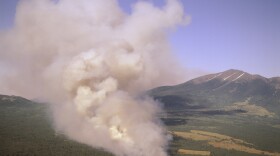The world’s largest ponderosa pine forest stretches across higher elevations from the San Francisco Peaks to the Arizona/New Mexico border. But in the last century, human intervention has threatened its health.
Thunderstorms roll across Arizona skies in July and August. The ponderosa pine forest evolved in a climate marked by these storms in summer, and snow and cold winds in winter. The pines regenerate best when there’s a good seed crop in autumn, followed by a moist summer monsoon, a sequence that happened only twice in the twentieth century.
People value this forest for a lot of different reasons--cool green boughs, the intoxicating scent in spring. Out in woods, Dick Fleishman, with the Coconino National Forest in Flagstaff, points out old growth ponderosas. They trees are called “yellow bellies,” because as they age their bark turns reddish-gold, and they’re great for wildlife.
“I don’t know, back off over here, there’s some good yellow guys over here,” says Fleishman. When they get old they start getting big and fat. Excellent for turkey roosts. These guys are real good for squirrels to move around in.”
Ponderosa pines grow on two and half million acres along Arizona’s Mogollon Rim. They spread across four national forests that people from Flagstaff, Springerville—and Phoenix—consider their backyard.
“This is our public lands and they’re our trust resources and that includes wildlife,” notes Shaula Hedwall, biologist with the U.S. Fish and Wildlife Service. To her, the ponderosa forest is more than just trees. It’s also home to threatened species like the Mexican spotted owl, but also more common forest animals. “So [it’s] not just the owl,” Hedwall says, “but all the prey species it depends on--voles, squirrels, the goshawk and its prey species; black bears, mountain lions, all of those species that the public really cares about.”
But the forest we know today was very different 150 years ago. Gila County supervisor Tommie Martin grew up in a ranching family in Payson, Arizona. She describes what her forebears saw back then. “When my great grandmother, the one that was in the wagon, came in. . . she talked about this as a ponderosa savanna. . . . She said you could drive a wagon in any direction. You could run a horse in any direction. It was open rolling grassy hillsides. There was smoke on the mountain all the time. And it was that way until about the twenties when they stopped the fires.”
Lightning typically sparked those fires. They would hug the ground, burning grasses and cleaning out needles and fallen branches. Frequent fire kept the forest thin and healthy. But the public came to see fire as the enemy. It burned valuable lumber and threatened property. The U.S. Forest Service rallied to extinguish every lick of flame.
But it turns out, ponderosas need fire. Without it, the forest became choked with small trees all fighting for moisture and room to grow. Dense doghair thickets of trees were wildly combustible. We’ve watched fires burn bigger and hotter, a half million acres in a fell swoop. Homeowners, recreationists, land managers, and ecologists have all learned this lesson the hard way. We fear for our homes which could burn down or be flooded when whole mountainsides are scorched. We’ve come to accept that the forest must be thinned--or else.
Henry Provencio, with the Coconino National Forest, is team leader of the Four Forest Restoration Initiative. He’s heard a lot of different responses: “Folks are concerned about old trees, folks are concerned about large trees, folks are concerned about fire; the ‘not in my backyard,’ ‘please in my backyard’ kind of mentality. So we really do hear from the range, the entire range of what expect to hear.”
He and many others feel a palpable sense of urgency. With big fires breathing down our necks, we may have only one chance to get it right. But to Provencio, 4FRI has a bigger goal: “A major emphasis of 4FRI--the emphasis of 4FRI--is forest restoration. It is not fire abatement. However, when you restore a forest and a fire-adapted forest like we have, that’s one of the benefits, is you get reduced fire behavior, you get fire acting more naturally.”
By now a lot of people have heard of 4FRI, but what is it? Who is it? And how will it happen? Answers to these questions will determine what the ponderosa pine forest looks like far into the future.
This series on 4FRI is funded in part by the Grand Canyon Trust.









